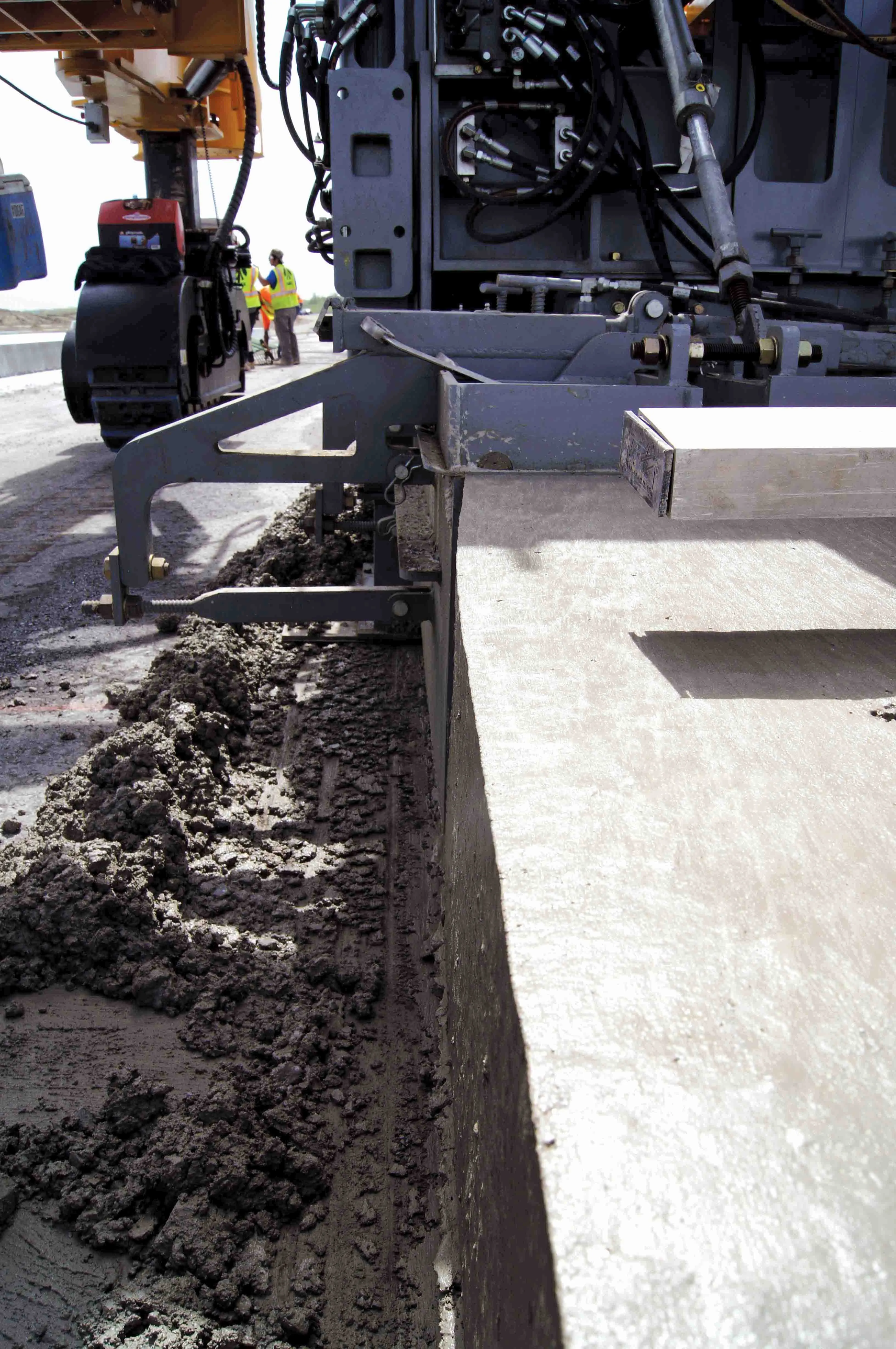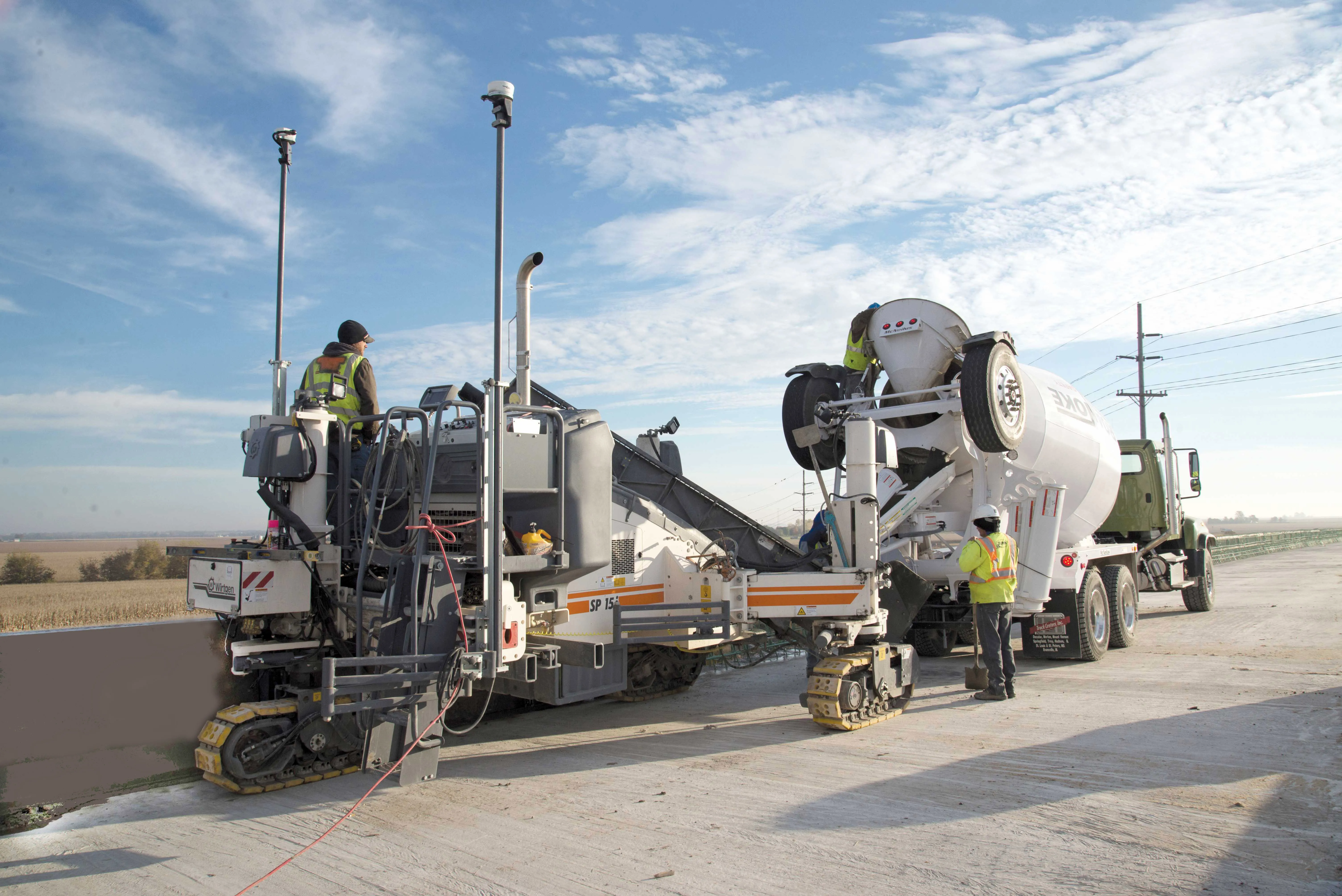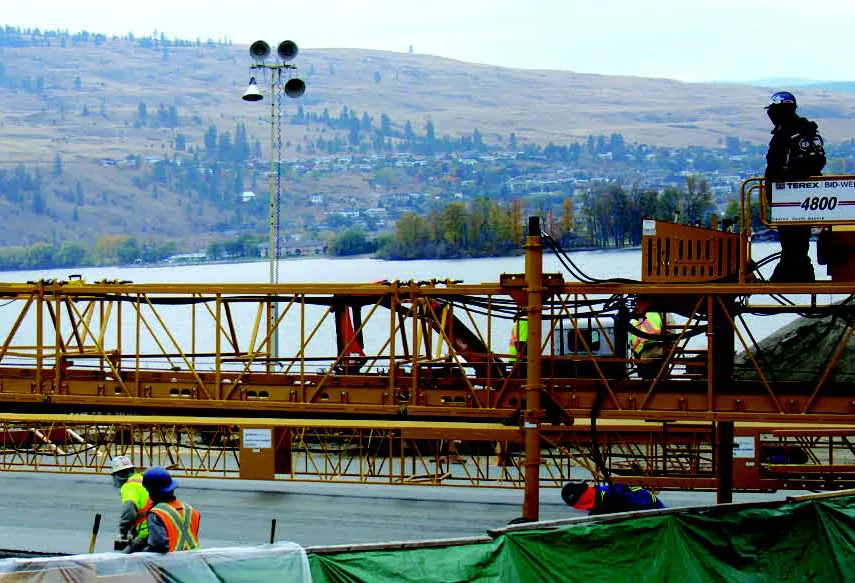When New York State Thruway wanted to experiment with unbonded concrete overlays, they chose an 8km, four-lane section of Interstate 90 near Hamburg as their test section. Surianello General Concrete, based in Buffalo, New York, won the bid to pave the 22.9cm thick concrete overlay.
The age and the design of the original roadway created a major paving challenge. It was built in the 1950s and didn’t conform to current geometry requirements for superhighways.
“They built it with a standard crown sectio
April 2, 2014
Read time: 4 mins
When New York State Thruway wanted to experiment with unbonded concrete overlays, they chose an 8km, four-lane section of Interstate 90 near Hamburg as their test section. Surianello General Concrete, based in Buffalo, New York, won the bid to pave the 22.9cm thick concrete overlay.
The age and the design of the original roadway created a major paving challenge. It was built in the 1950s and didn’t conform to current geometry requirements for superhighways.
“They built it with a standard crown section going through all horizontal curves. No super elevations,” said Frank Surianello, president of Surianello General Concrete (SGC). “Now, to conform to2410 Federal Highway Administration guidelines for superhighways, you have to adjust and make your transition from normal crown to full bank horizontal curves. The depth of the blacktop underlayment at these locations varied from 38 to 191mm. Anchoring traditional baskets would be a challenge.
“Since this was an overlay, the next issue was setting string. You’d have to pre-drill the holes for the stakes and spend a lot of time and effort anchoring them. Plus, stringline basically holds the job hostage because your access is very limited.”
The American Concrete Pavement Association (ACPA) was involved throughout the design and implementation phases of the project. Surianello, who was the 2013 chairman of ACPA, and his company worked closely with the association on the Interstate 90 overlay.
The SGC-ACPA answer to both the transverse joint and stringline challenge for SGC was a218 Gomaco four-track GHP-2800 slipform concrete paver equipped with a new independent IDBI attachment and a 265 Leica Geosystems 3D stringless guidance control system. Both the 3D and IDBI systems were new to SGC. Before SGC took their new paver out on a project, they wanted to do training and a test pour at their headquarters. Gomaco sent members of their 3D team, Service Department, and an instructor from Gomaco University to provide hands-on training.
“We did a 45.7 metre test pour at our facilities in Buffalo where we trained our operators on the dowel bar inserter and the stringless,” Surianello said. “The hands-on experience allowed us to get our ducks in a row so when we mobilised for the actual project, everyone knew their job and we could hit the ground running.”
With training completed and the crew confident in their abilities, Surianello moved their GHP-2800 onsite and began paving the overlay project on Interstate 90. Concrete was supplied by their own central mix batch plant batching 6.9m³. Tri-axle dump trucks carried the concrete to the paver on the existing road and dumped directly onto it in front of the paver. Tight conditions on the project didn’t allow much room for haul roads or a placer/spreader.
The GHP-2800 paved 7.6m wide and 22.9cm thick. Every 4.6m the Gomaco IDBI was placing 25 dowel bars for the highway’s transverse joint. Each bar was 38mm in diameter, 45.7cm long, and placed at a 30.5cm centre spacing across the width of the slab.
The Leica 3D system was also said to work well for the stringless rookies. Surianello teamed up with a local surveying company to build their paving models.
“They surveyed the existing blacktop and built the models to maximise efficiencies for depth,” Surianello explained. “The company, Innovative GPS Solutions LLC, actually went through Gomaco University’s stringless class and they did a very good job building our models for us.”
Real-time pavement smoothness behind the GHP-2800 was monitored by two paver-mounted GSI (Gomaco Smoothness Indicator) units. The state of New York uses the two-tenths blanking band to monitor the smoothness of their new roads.
“It’s a California-type profilograph, two-tenths blanking band, 5inches per mile (79 mm/km), so it’s pretty lenient,” Surianello said. “When we profilographed this project, we were getting readings of zero, or 0.1inch (2 mm). The readings were so good that I was skeptical, so I asked another contractor to bring out their lightweight profiler and see what kind of numbers it read. We were getting in the 70s on the IRI, with readings as low as 30.”
Surianello’s paving production averaged around 792m per day, or between 1.8 to 2.4m per minute. The GSI showed them they were reaching maximum smoothness results at that speed with the concrete paving mix they were using.
A new Gomaco T/C-600 texture/cure machine followed the GHP-2800 applying a longitudinal tine and white spray cure. Wheels attached to the T/C-600’s sensors allowed steering and grade control off the new slab on the stringless project.
Although it’s too early yet for the Thruway Authority to have any results on the success of the concrete overlay test, Surianello said, “I’ve had some industry feedback stating straight out that this is the smoothest concrete pavement that anybody has ever ridden on in New York.”
The age and the design of the original roadway created a major paving challenge. It was built in the 1950s and didn’t conform to current geometry requirements for superhighways.
“They built it with a standard crown section going through all horizontal curves. No super elevations,” said Frank Surianello, president of Surianello General Concrete (SGC). “Now, to conform to
“Since this was an overlay, the next issue was setting string. You’d have to pre-drill the holes for the stakes and spend a lot of time and effort anchoring them. Plus, stringline basically holds the job hostage because your access is very limited.”
The American Concrete Pavement Association (ACPA) was involved throughout the design and implementation phases of the project. Surianello, who was the 2013 chairman of ACPA, and his company worked closely with the association on the Interstate 90 overlay.
The SGC-ACPA answer to both the transverse joint and stringline challenge for SGC was a
“We did a 45.7 metre test pour at our facilities in Buffalo where we trained our operators on the dowel bar inserter and the stringless,” Surianello said. “The hands-on experience allowed us to get our ducks in a row so when we mobilised for the actual project, everyone knew their job and we could hit the ground running.”
With training completed and the crew confident in their abilities, Surianello moved their GHP-2800 onsite and began paving the overlay project on Interstate 90. Concrete was supplied by their own central mix batch plant batching 6.9m³. Tri-axle dump trucks carried the concrete to the paver on the existing road and dumped directly onto it in front of the paver. Tight conditions on the project didn’t allow much room for haul roads or a placer/spreader.
The GHP-2800 paved 7.6m wide and 22.9cm thick. Every 4.6m the Gomaco IDBI was placing 25 dowel bars for the highway’s transverse joint. Each bar was 38mm in diameter, 45.7cm long, and placed at a 30.5cm centre spacing across the width of the slab.
The Leica 3D system was also said to work well for the stringless rookies. Surianello teamed up with a local surveying company to build their paving models.
“They surveyed the existing blacktop and built the models to maximise efficiencies for depth,” Surianello explained. “The company, Innovative GPS Solutions LLC, actually went through Gomaco University’s stringless class and they did a very good job building our models for us.”
Real-time pavement smoothness behind the GHP-2800 was monitored by two paver-mounted GSI (Gomaco Smoothness Indicator) units. The state of New York uses the two-tenths blanking band to monitor the smoothness of their new roads.
“It’s a California-type profilograph, two-tenths blanking band, 5inches per mile (79 mm/km), so it’s pretty lenient,” Surianello said. “When we profilographed this project, we were getting readings of zero, or 0.1inch (2 mm). The readings were so good that I was skeptical, so I asked another contractor to bring out their lightweight profiler and see what kind of numbers it read. We were getting in the 70s on the IRI, with readings as low as 30.”
Surianello’s paving production averaged around 792m per day, or between 1.8 to 2.4m per minute. The GSI showed them they were reaching maximum smoothness results at that speed with the concrete paving mix they were using.
A new Gomaco T/C-600 texture/cure machine followed the GHP-2800 applying a longitudinal tine and white spray cure. Wheels attached to the T/C-600’s sensors allowed steering and grade control off the new slab on the stringless project.
Although it’s too early yet for the Thruway Authority to have any results on the success of the concrete overlay test, Surianello said, “I’ve had some industry feedback stating straight out that this is the smoothest concrete pavement that anybody has ever ridden on in New York.”









